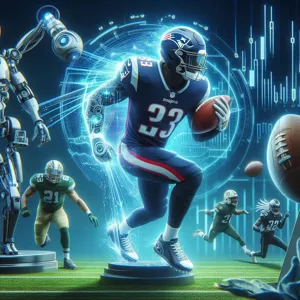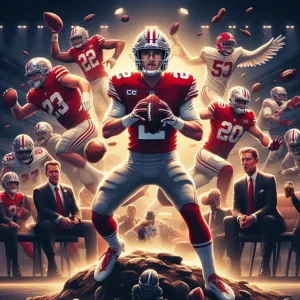As the NFL prepares for its highly anticipated annual draft, teams across the league are poised to make pivotal decisions that could define their futures.
The NFL Draft isn’t just an event; it’s a strategic battleground where franchises seek to uncover hidden gems and secure the next generation of football talent. With each selection, the potential for greatness—both for individual players and the teams that choose them—hangs in the balance. In this blog post, we’ll delve into the crucial role the NFL Draft plays in shaping team success, exploring how astute scouting, careful evaluations, and strategic foresight can transform a struggling franchise into a championship contender. Join us as we navigate the intricate web of talent acquisition, historical impacts, and the strategies that define this critical moment in professional football. Whether you’re a die-hard fan or a casual observer, understanding the significance of the NFL Draft will deepen your appreciation for the game and the teams you love.
1. Introduction: The NFL Draft as a pivotal event in team strategy

The NFL Draft stands as one of the most significant events on the football calendar, a crucial juncture where teams mold their future and set the course for the upcoming season and beyond. As the excitement builds each spring, teams scramble to analyze talent, strategize their picks, and negotiate trades, all in a bid to assemble a roster that can compete at the highest level. The draft is not just about selecting players; it represents a strategic chess game where every decision can ripple through the franchise for years to come.
For fans, the draft embodies hope and anticipation. It’s the moment when dreams are realized for young athletes who have devoted their lives to the sport, and it’s a chance for franchises to reinvigorate their lineup with fresh talent. The stakes are incredibly high—teams that excel in the draft often find themselves on paths to success, while those that falter can struggle to recover.
As we delve deeper into the impact of the NFL Draft, we’ll explore how it influences team dynamics, shapes coaching strategies, and affects fan engagement. From evaluating college prospects to managing salary caps, the draft is a multifaceted event that can make or break a team’s future. Join us as we navigate through the intricacies of this pivotal occasion and uncover the profound role it plays in shaping not only teams but the very landscape of the National Football league.
2. The Historical Context of the NFL Draft
The Historical Context of the NFL Draft
To fully appreciate the significance of the NFL Draft in shaping team success, it’s essential to delve into its historical context. Established in 1936, the NFL Draft was initially conceived as a response to the growing need for a structured and equitable way to distribute new talent among teams. Prior to the draft, franchises often engaged in aggressive bidding wars for college players, which led to an uneven playing field that favored wealthier teams. The inception of the draft marked a pivotal shift in the league, emphasizing parity and opportunity for all franchises, regardless of their financial status.
Over the decades, the draft has evolved, reflecting broader changes in the sport and society. The introduction of the modern draft system with its allocation of picks, trade possibilities, and salary caps has transformed it into a highly strategic event. Teams now invest significant resources into scouting and analytics, seeking to unearth hidden gems among college prospects. The stakes are higher than ever, as a successful draft can set a franchise on the path to glory, while a series of missteps can lead to years of rebuilding and disappointment.
Notably, the draft has served as a launching pad for some of the most iconic players in NFL history. From Hall of Famers like Johnny Unitas and Joe Montana to contemporary stars like Patrick Mahomes and Aaron Donald, the draft has consistently been a stage where future legends are born. Each year, the anticipation builds as fans and analysts alike speculate on which fresh talents will make their mark and transform the fortunes of their teams.
Understanding the historical context of the NFL Draft not only enhances our appreciation of its current significance but also sheds light on the intricate strategies employed by teams as they navigate the complexities of player selection. As we look to the future, the draft remains a cornerstone of NFL operations, embodying the hope and ambition of franchises eager to build successful dynasties.
3. Understanding the Draft Process: How It Works

The NFL Draft is a highly anticipated event that serves as a pivotal moment in the lifecycle of every team. Understanding how this process works is crucial for fans and analysts alike, as it directly influences a team’s future success.
At the heart of the NFL Draft lies a systematic approach that begins with the evaluation of eligible college players. Teams spend countless hours scouting, conducting interviews, and analyzing game footage to identify prospects that fit their needs. This extensive preparation culminates in the NFL Scouting Combine, where athletes showcase their skills through drills, interviews, and psychological tests. Here, teams gather essential data that aids in their decision-making process.
Once the Combine concludes, the draft order comes into play. It is determined by the teams’ records from the previous season, with the worst-performing teams getting the first pick. This order incentivizes teams to improve their standings, making the draft a vital aspect of competitive balance within the league.
As the draft unfolds, teams have a limited time to make their selections, adding an element of urgency and strategy to the proceedings. General managers and coaches must weigh their options carefully, considering not just the immediate impact of a player but also how they fit into the broader vision of the team. Trade offers often surface during this time, allowing teams to maneuver up or down the draft board in pursuit of their ideal picks.
The culmination of the draft process results in a fresh wave of talent entering the league. However, the work doesn’t stop there. Teams must then integrate these new players into their systems, providing them with the necessary support and training to help them develop. The success of a draft class is often measured years down the line, as many players take time to adjust to the rigors of professional football.
In essence, the NFL Draft is not just a selection process; it’s a strategic game of chess that can define franchises for years to come. By understanding the intricacies of this event, fans can gain deeper insights into their team’s direction and the potential impact of each new player on the field.
4. The Importance of Scouting and Player Evaluation
The Importance of Scouting and Player Evaluation
In the high-stakes world of the NFL Draft, the ability to identify and evaluate talent is paramount. Scouting isn’t just about watching game footage; it’s a meticulous process that encompasses a variety of assessments, from physical attributes to psychological readiness. Teams invest countless hours and resources into this endeavor, recognizing that the decisions made during this period can define a franchise’s future for years to come.
Scouts are tasked with more than merely compiling stats; they must analyze a player’s performance under pressure, assess their adaptability to different game situations, and evaluate their character and work ethic. This holistic approach can reveal a wealth of information that raw statistics alone may not convey. For instance, a quarterback’s poise in the pocket, a wide receiver’s ability to create separation, or a defensive lineman’s tenacity can all be determining factors in how well these athletes will transition to the professional level.
Moreover, the NFL Combine serves as a crucial element in this evaluation process, providing a platform for players to showcase their physical abilities in front of coaches and scouts. Here, speed, agility, strength, and endurance are put to the test, offering insights that can either bolster a player’s draft stock or raise red flags. But the importance of scouting goes beyond physical tests; interviews with players can provide a glimpse into their mindset, helping teams gauge whether a player’s personality aligns with their culture and values.
As the draft approaches, teams must synthesize all this information to make informed decisions. The art of scouting and player evaluation not only influences which prospects are selected but also shapes the strategies teams employ to build a cohesive and competitive roster. Ultimately, a comprehensive approach to scouting can lead to the acquisition of future stars, while overlooking key indicators can result in missed opportunities and long-term repercussions.
In essence, the NFL Draft is not just a selection process; it is a complex interplay of strategy, insight, and vision. The teams that excel in scouting and player evaluation are the ones that lay the groundwork for success, transforming potential into performance and ensuring their place in the ever-evolving landscape of professional football.
5. Analyzing Team Needs: Building a Balanced Roster

When it comes to the NFL Draft, the importance of analyzing team needs cannot be overstated. A successful draft is not merely about selecting the most talented players available; it’s about strategically filling gaps in your roster to create a well-rounded team that can compete at the highest level. Each franchise enters the draft with a unique set of challenges and opportunities, often influenced by the previous season’s performance, current roster composition, and future aspirations.
To begin building a balanced roster, teams must conduct a thorough assessment of their current players. This involves evaluating positional strengths and weaknesses, understanding the development trajectory of younger athletes, and considering the impact of injuries on player performance. For instance, a team that struggled with pass defense last season may prioritize drafting a top-tier cornerback or a dynamic safety to bolster its secondary. Conversely, a franchise with a solid offensive line might focus on enhancing its pass-catching options to diversify its offensive strategies.
In addition to immediate needs, front offices must also think long-term. The NFL is notorious for its high turnover rate, whether due to free agency or retirements, making it imperative for teams to plan for the future. Young, emerging talent can provide the foundation for sustained success, and drafting players who fit well within the team’s system and culture can foster a cohesive unit that thrives together.
Moreover, analyzing team needs is not limited to just the draft itself. It requires a holistic approach that includes scouting reports, player interviews, and a comprehensive understanding of the draft class as a whole. Teams often create multiple draft boards, ranking players based on their fit for specific positions and overall team philosophy.
Ultimately, the goal is to assemble a roster that not only addresses immediate deficiencies but also promotes depth and versatility. A well-balanced team stands a better chance of weathering the inevitable challenges of an NFL season, from injuries to performance slumps. By carefully analyzing team needs and making informed decisions during the draft, franchises can lay the groundwork for successful seasons to come, maximizing their potential both on and off the field.
6. Case Studies: Teams That Excelled Post-Draft
The NFL Draft is more than just a ceremonial event; it is a pivotal moment that can define the trajectory of a franchise for years to come. To illustrate this, let’s explore a few case studies of teams that have not only excelled in the draft but have also transformed their fortunes in the seasons that followed.
**The Kansas City Chiefs (2017 Draft)**
The 2017 NFL Draft marked a turning point for the Kansas City Chiefs, who made a bold move by trading up to secure quarterback Patrick Mahomes. Initially seen as a gamble, Mahomes quickly proved his critics wrong, showcasing an extraordinary ability to make plays and read defenses. His impact was immediate, leading the Chiefs to a playoff appearance in his first season as a starter and ultimately culminating in a Super Bowl victory in 2020. The Chiefs’ foresight in drafting Mahomes is a testament to how the right choice in the NFL Draft can redefine a franchise and establish a winning culture.
**The Baltimore Ravens (2018 Draft)**
The Baltimore Ravens also made headlines during the 2018 Draft when they selected quarterback Lamar Jackson in the first round. Initially viewed as a controversial pick, Jackson’s electrifying playing style and dual-threat capabilities quickly turned the team’s fortunes around. Under his leadership, the Ravens clinched the AFC North title and made a deep playoff run, with Jackson earning the NFL MVP award in 2019. The Ravens’ strategic planning and commitment to Jackson’s development exemplify how a successful draft can not only bring in talent but also revamp a team’s entire strategy and identity.
**The San Francisco 49ers (2019 Draft)**
The San Francisco 49ers’ 2019 Draft strategy was a masterclass in building a competitive roster. By selecting defensive end Nick Bosa with the second overall pick, they added a transformative player to their defensive line. Bosa’s immediate impact was felt throughout the season, as he played a critical role in the 49ers reaching Super Bowl LIV. Additionally, the 49ers’ later picks, including receiver Deebo Samuel and linebacker Dre Greenlaw, further underscored the importance of a well-rounded draft strategy that addresses multiple facets of the team. The success of these selections has solidified the 49ers as perennial contenders in the league.
These case studies illustrate a fundamental truth: the NFL Draft is not merely an exercise in talent acquisition but a strategic opportunity that can shape the identity and success of a franchise. Teams that approach the draft with foresight and a clear vision of their needs can lay the foundation for long-term success, making the draft a critical component in navigating the ever-evolving landscape of professional football.
7. The Impact of Drafting on Long-term Franchise Success

The impact of drafting on long-term franchise success cannot be overstated. Each year, NFL teams gather in anticipation of the draft, a defining moment that can establish the trajectory of a franchise for years to come. The players selected during this pivotal event are not merely new faces on the roster; they are the potential cornerstones of a team’s future, capable of transforming an organization’s fortunes from mediocrity to greatness.
A well-executed draft can create a ripple effect throughout the team. When a franchise secures standout players, it not only bolsters immediate performance on the field but also enhances team morale and fan engagement. Think of legendary quarterbacks like Tom Brady or Peyton Manning, whose draft selections were not just lucky breaks but pivotal moments that reshaped their franchises. These players become the faces of their teams, leading them to numerous victories and building a loyal fanbase.
Conversely, poor drafting decisions can lead to years of disappointment. Teams that consistently miss on high-profile picks often find themselves trapped in a cycle of rebuilding, watching rival franchises thrive with the players they passed on. The importance of diligent scouting, thorough analysis, and strategic decision-making in the lead-up to the draft cannot be emphasized enough. It is essential for teams to assess not just the talent of individual players, but also how they fit into the team’s culture and long-term vision.
Moreover, the draft sets the tone for a franchise’s identity. A team that prioritizes speed and athleticism may focus on selecting dynamic playmakers, while one that values grit and resilience may lean toward robust linemen or hard-hitting defenders. The choices made during the draft can reflect and influence coaching philosophies, team strategies, and ultimately, the type of football that fans come to expect.
In conclusion, the NFL draft is more than just an annual event; it is a critical juncture in a franchise’s journey. Teams that approach this process with foresight and a clear strategy are often the ones that enjoy sustained success. As the league evolves and new talent emerges, the ability to navigate the complexities of the draft will remain a vital component in shaping the future of NFL franchises.
8. The Role of Trades and Acquisitions in the Draft
The NFL Draft is often heralded as the cornerstone of a team’s future success, but its impact is significantly magnified by the strategic maneuvers of trades and acquisitions that happen both leading up to and during the event. Teams are not just passively selecting from available talent; they’re actively engaging in a game of chess, making calculated moves to position themselves for the best possible outcomes.
Consider this: a team may identify a potential star player in the draft but find themselves in a less-than-ideal pick position. This is where trades come into play. By leveraging existing players, future draft picks, or even cash considerations, teams can maneuver up the draft board to secure that coveted prospect. These trades can significantly alter the landscape of the draft, as one team’s bold move can ripple through the choices of others, affecting who remains available for selection.
Acquisitions also play a vital role in a team’s draft strategy. Teams often look to fill gaps in their roster through trades before the draft, allowing them to approach the event with a more focused mindset. For instance, if a team trades for a seasoned quarterback, they may choose to invest their draft picks in bolstering their defense instead of searching for a new signal-caller. This dual strategy of drafting and trading enables teams to create a well-rounded roster, tailored to their specific needs and the overall vision for their future.
Moreover, the dynamics of trades and acquisitions aren’t just limited to the draft day itself; they can shape the narrative of an entire offseason. The anticipation of a blockbuster trade can shift the focus away from the draft, influencing how teams prioritize their needs and adjust their strategies accordingly.
In essence, understanding the role of trades and acquisitions in the draft process is crucial for any NFL team aiming for sustained success. It’s not merely about picking talented players; it’s about orchestrating a comprehensive approach that combines strategic foresight with opportunistic decision-making. As teams navigate the complexities of the draft, those that excel at leveraging trades and acquisitions will find themselves better positioned to build competitive rosters that can thrive in the ever-evolving landscape of the NFL.
9. Evaluating Draft Classes: Success Metrics
When it comes to evaluating the effectiveness of a draft class, success metrics are vital in understanding how well a team has positioned itself for future triumphs. The NFL Draft is not just a one-day spectacle; it’s a multi-year investment that can define a franchise’s trajectory. To gauge the success of a draft class, teams and analysts typically consider several key metrics.
First and foremost, the performance of drafted players in their rookie seasons sets a foundational benchmark. Stats such as yards gained, tackles made, and touchdowns scored provide immediate insights into a player’s impact on the field. However, it’s essential to look beyond initial performances. Longevity and durability also play significant roles; a player who remains healthy and consistently contributes over several seasons is often more valuable than a one-hit wonder.
Another critical metric is the player’s contribution to team success. This can be measured by examining how drafted players help their teams reach the playoffs or win championships. For instance, a quarterback selected in the first round who leads his team to multiple postseason appearances elevates the perceived success of that draft class.
Moreover, evaluating the overall depth of a draft class is crucial. A team that finds late-round gems—players who outperform their draft position—demonstrates a keen eye for talent and scouting. The ability to identify and develop talent from the later rounds can often balance out any early-round missteps, proving that success in the draft is about quality and depth.
Finally, the overall impact on the roster and team culture cannot be overlooked. Draft classes should not only fill immediate needs but also enhance team dynamics, competitiveness, and future growth. Teams that select players who embody their values and fit their schemes often find more sustainable success.
In summary, evaluating draft classes involves a multi-faceted approach that looks at immediate performance, long-term contributions, depth of talent, and cultural fit. By analyzing these metrics, teams can refine their strategies and hopefully create a winning formula that secures their place in NFL history.
10. The Influence of Analytics on Draft Decisions
In today’s fast-paced and data-driven sports environment, analytics has emerged as a formidable force in shaping NFL draft decisions. Gone are the days when team scouts relied solely on intuition and firsthand observations; now, they are armed with a plethora of statistics, predictive models, and comprehensive performance metrics. This analytical revolution is not just a trend; it’s a fundamental shift that can mean the difference between a franchise’s rise to greatness and its descent into mediocrity.
Teams are now utilizing advanced metrics to evaluate player performance on a granular level. They analyze everything from a quarterback’s throwing velocity to a linebacker’s ability to read plays, considering factors that go beyond traditional statistics. For instance, teams may employ data visualization techniques to assess a receiver’s route efficiency, providing insight into how well a player can create separation from defenders. This level of detailed analysis helps teams identify hidden gems who may have been overlooked by others based on conventional scouting reports.
Moreover, analytics also plays a crucial role in risk assessment. GMs and coaches can use historical data to understand the likelihood of a player’s success based on their college performance, physical attributes, and even injury history. By examining trends and benchmarks from previous drafts, teams can make informed decisions that maximize their chances of landing a franchise quarterback or a game-changing defensive lineman.
The integration of analytics doesn’t stop at the draft table. It extends into post-draft development, where teams continuously monitor their rookies’ progress against established performance metrics. This data-driven approach enables teams to tailor training regimens and game strategies, ensuring that newly drafted players transition smoothly into the professional arena.
Ultimately, as the NFL evolves, the influence of analytics on draft decisions will only continue to grow. Teams that embrace this data-centric philosophy are better positioned to make strategic picks that align with their long-term vision for success. In the high-stakes world of the NFL Draft, leveraging analytics effectively can transform a team’s fortunes and set the stage for sustained excellence on the field.
11. Common Draft Day Mistakes and How to Avoid Them
The NFL Draft is a high-stakes event that can significantly influence a franchise’s future, but it’s also fraught with pitfalls that can derail even the most promising teams. Understanding these common Draft Day mistakes—and how to steer clear of them—can be the difference between building a championship contender and floundering in mediocrity.
One of the most prevalent mistakes teams make is overvaluing a player based on workout metrics rather than game tape. It’s easy to fall victim to the allure of a standout combine performance, but history has shown that athletic prowess doesn’t always translate to on-field success. To avoid this, teams should prioritize a comprehensive evaluation process that considers a player’s performance throughout their college career, including their decision-making, adaptability, and ability to thrive under pressure.
Another critical misstep is neglecting team needs in favor of the “best player available” approach, especially when that player doesn’t fit into the existing roster’s scheme. While it’s essential to draft talent, it’s equally important to ensure that the player aligns with the team’s strategic vision. Teams can avoid this by conducting thorough assessments of their current roster and identifying gaps that need to be filled before Draft Day.
Additionally, failing to have a clear draft strategy can lead to chaos and missed opportunities. Teams often get caught up in the moment, making impulsive decisions that can have long-term consequences. Establishing a well-defined plan, complete with contingency options for various scenarios, can help teams stay focused and make rational choices when the pressure is on.
Lastly, teams should be cautious about trading up in the draft without a solid understanding of the implications. While moving up can provide access to elite talent, it often comes at a steep price—one that can deplete a team’s future pick resources. To mitigate this risk, organizations should carefully evaluate the potential return on investment for any trade and ensure that the player they’re targeting is a worthy investment.
By recognizing these common Draft Day mistakes and implementing strategies to avoid them, teams can better position themselves for success, ultimately crafting the roster that will lead them into a brighter future. The NFL Draft is not just an event; it’s a critical juncture in a franchise’s journey, and navigating it wisely can set the tone for years to come.
12. The Evolution of College Football’s Role in the Draft
The Evolution of College Football’s Role in the Draft
As we delve into the intricacies of the NFL Draft, it’s impossible to overlook the profound impact that college football has had on shaping its trajectory. The draft serves not merely as a selection process but as a pivotal bridge connecting the collegiate game to the professional arena. Over the years, the role of college football in the draft has evolved, becoming increasingly intricate and significant.
In the early days of the NFL, scouting was a rudimentary affair. Teams relied heavily on word-of-mouth and basic statistics, often missing out on hidden gems playing in smaller conferences. Fast forward to today, and the landscape has changed dramatically. College football now serves as a vital feeder system, with a sophisticated network of scouts and analytics that dissect every aspect of a player’s performance. This meticulous attention to detail has transformed the draft into a high-stakes event where the right pick can redefine a franchise’s future.
Moreover, the rise of college football’s popularity has amplified the visibility of prospects. With games broadcasted nationally and the advent of social media, players are under constant scrutiny. Fans and teams alike can follow the journey of potential draftees from their high school days through their collegiate careers, analyzing game footage, stats, and even social media presence. This heightened exposure means that teams must be more discerning than ever, as every move a player makes can impact their draft stock.
Additionally, the rules surrounding college eligibility and the impact of the Transfer Portal have further complicated the draft landscape. Players are now making strategic decisions about when to enter the draft based on their performance and the potential for success at the next level. This evolution has led to a more dynamic draft process, where teams must not only evaluate a player’s talent but also their character, work ethic, and adaptability.
Ultimately, the relationship between college football and the NFL Draft is a symbiotic one. As the college game continues to evolve, so too will the strategies employed by NFL teams in scouting and selecting talent. The draft is no longer just about filling roster spots; it’s about building a foundation for sustainable success. Understanding this evolution is crucial for teams aiming to navigate the future effectively, making informed choices that will resonate for years to come.
13. The Fan Perspective: How Drafting Affects Team Morale
The NFL Draft is not just a pivotal event for team rosters; it’s a moment that reverberates through the hearts and minds of fans. When a team makes a selection, it sends a powerful message about its direction and aspirations, and fans are keenly aware of the implications. From the hopeful anticipation of landing a franchise quarterback to the excitement of acquiring a game-changing defensive player, each draft choice can invigorate or deflate the fan base.
Imagine the atmosphere in a packed stadium on draft day, where fans eagerly gather to witness the unveiling of their team’s future. The buzz in the air is palpable, filled with dreams of playoff runs and championship glory. A well-received draft pick can ignite a sense of optimism, galvanizing the community and fostering a renewed loyalty among fans. Conversely, a controversial pick or a perceived reach can lead to disappointment, sparking debates on social media and among friends at the bar. Fans often feel a personal investment in these decisions, and their reactions can significantly affect the team’s morale and public perception.
Moreover, the draft is a unique opportunity for teams to connect with their fan base. Engaging events, live broadcasts, and interactive content allow fans to feel included in the decision-making process, deepening their emotional investment in the team. When a franchise successfully targets players who resonate with its supporters—whether due to local ties, standout college careers, or charismatic personalities—the result is often a more vibrant fan culture.
Ultimately, the players chosen during the draft are more than just names on a roster; they represent hope, ambition, and the potential for greatness. By navigating the draft effectively and considering the fan perspective, teams can not only bolster their on-field performance but also enhance the overall morale and passion of their devoted supporters, creating a symbiotic relationship that drives success on and off the field.
14. Future Trends: Changes in the NFL Draft Landscape
As we look toward the future, the NFL Draft is poised to undergo significant transformations that could redefine the landscape of player selection and team-building strategies. The evolution of technology, analytics, and player development methodologies will undoubtedly shape how teams approach the draft process.
One prominent trend is the increasing reliance on data analytics. Teams are now employing advanced metrics and algorithms to analyze player performance and potential in more nuanced ways than ever before. This data-driven approach allows franchises to identify hidden gems and reduce the risk associated with high-stakes draft picks. As teams continue to leverage big data, expect a shift toward selecting players based on predictive analytics, which could lead to a more scientifically grounded approach to drafting.
Additionally, the rise of virtual scouting and remote evaluations has transformed how teams assess talent. With the advent of high-quality streaming technology and comprehensive highlight reels, scouts can evaluate players from the comfort of their offices. This trend allows teams to cast a wider net, discovering talent from smaller colleges and international leagues that may have previously flown under the radar.
Moreover, the increasing emphasis on player wellness and mental health is likely to influence draft decisions. Teams are becoming more aware of the importance of a player’s off-field behavior and mental resilience. As a result, franchises may prioritize character assessments and psychological evaluations, aiming to draft not just the most physically gifted athletes but also those who exhibit leadership qualities and emotional intelligence.
Lastly, as the NFL continues to expand its global footprint, we may see an influx of international players entering the draft. This trend could lead to a more diverse talent pool, with teams scouting talent from countries that have traditionally been overlooked. The potential for international players to make an impact in the NFL could shift team strategies, as franchises begin to invest more resources in global scouting networks.
In summary, the future of the NFL Draft promises to be an exciting evolution, characterized by a combination of technological advancements, a focus on player well-being, and an expanding global talent pool. Teams that adapt to these changes and embrace new methodologies will be better positioned to achieve long-term success in the competitive landscape of professional football. As we prepare for the next draft day, it’s clear that the decisions made during this critical event will continue to shape the future of franchises for years to come.
15. Conclusion: The Lasting Legacy of the NFL Draft on Team Success
In conclusion, the NFL Draft stands as a monumental event in the professional football landscape, embodying the hopes and aspirations of franchises and fans alike. It is more than just a selection of college athletes; it is a strategic juncture that can redefine the trajectory of a team for years to come. The legacy of the draft is woven into the fabric of NFL success stories, where teams that have excelled in scouting, analysis, and decision-making during this critical event have often reaped the rewards on the field.
Each draft class can bring transformative talent capable of turning struggling franchises into playoff contenders, or even champions. The ability to identify and cultivate potential, combined with effective coaching and development, ensures that the impact of the draft extends far beyond the initial selection day. It shapes team identities, influences locker room dynamics, and can even alter fan engagement levels, reigniting community pride and support.
As we look to the future, the NFL Draft will continue to be a pivotal moment that not only affects the immediate fortunes of teams but also contributes to the long-term health and competitiveness of the league. The stories of overlooked prospects emerging as superstars, and the once-promising players who fell short, remind us that the draft is as much an art as it is a science. For those teams that embrace this complexity and approach the draft with foresight and diligence, the potential for greatness is not just a dream—it is an achievable reality, one that leaves an indelible mark on the history of the franchise and the sport itself.
As we conclude our exploration of the NFL Draft and its pivotal role in shaping team success, it’s clear that this annual event is more than just a selection process; it’s a strategic cornerstone that can define a franchise’s future. From identifying emerging talent to nurturing player development, the decisions made during draft day resonate for years to come, impacting not only the team’s performance but also the fans’ loyalty and excitement. As the landscape of the league continues to evolve, understanding the intricacies of the draft will be essential for teams aiming to build a winning legacy. Whether you’re a die-hard fan, an aspiring coach, or a budding analyst, the NFL Draft offers a compelling glimpse into the future of football, where dreams are realized, and new legends are born. So, stay tuned as we watch these young athletes embark on their professional journeys—who knows, the next big star might just be waiting for their moment to shine!






